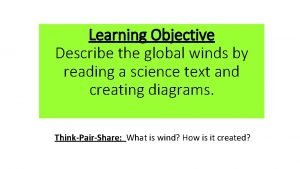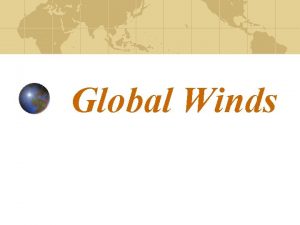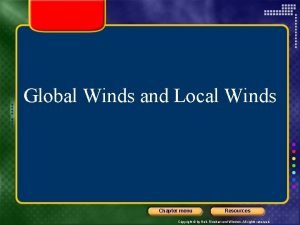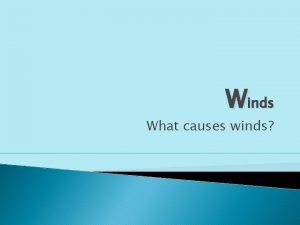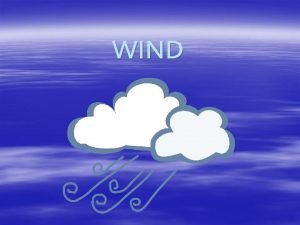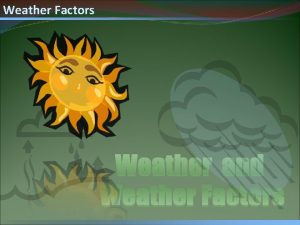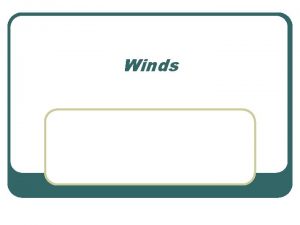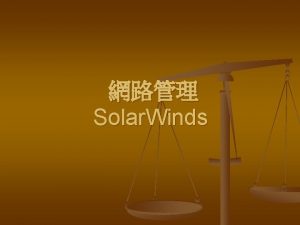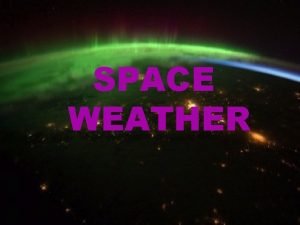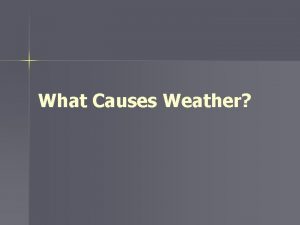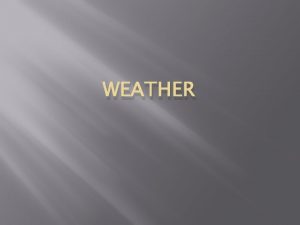Weather Factors Winds What Causes Winds Ms De










- Slides: 10

Weather Factors Winds What Causes Winds? Ms. De Los Rios Science

Vocabulary 5. 5 1. Wind- The horizontal movement of air from an area of high pressure to an area of lower pressure. 2. Anemometer- An instrument used to measure wind speed. 3. Local Winds- Winds that blow over short distances. 4. Sea Breeze- The flow of cooler air from an ocean or lake towards land 5. Land Breeze- The flow of air from land to a body of water. 6. Windchill Factor- The increase cooling that a wind can cause.

What Causes Winds? Differences in air pressure cause the air to move • Air is fluid allowing to move from one place to another. • A wind is the movement of air parallel to Earth’s surface. • Winds move from areas of h. p. to areas of l. p. Most differences in air pressure are caused by the unequal heating of the atmosphere • As air over heated surfaces expands and becomes less dense, its air pressure decreases. • If nearby air is cooler, it will flow under the warmer, less dense air.

Convection Currents

Convection currents form on-shore winds in the daytime. warmer weather. On a low flight over varying surfaces, the pilot will encounter updrafts over pavement or barren places and downdraft over vegetation and water. This can be avoided by flight at higher altitudes. When the larger convection currents form cumulus clouds, the pilot will invariably find smooth air above the cloud level.

Measuring Wind pg. 178 Winds are described by their direction and speed • Wind can blow in all directions: north, south, east, and west • Winds direction determined with a wind vane. • Wind speed is measured with an anemometer. • A wind is named for the direction it blows from. Example North wind blows from the north toward the south.

Winds Wind Direction and Speed Based on the direction of the wind vane, which direction would the kite be flying?

What Causes Winds? pg. 178 Winds that blow over short distances are called local winds. They are caused by: The unequal heating of Earth’s surface within a small area and form only when large-scale winds are weak. Two types of local winds: Sea breezes -is a local wind that blows from an ocean. During the day land warms faster than water. The air above the land heats and rises, and cool air from the ocean flows in to take its place. At night the process is reversed, land cools faster than the ocean. The flow of air from land to a body of water forms a land breeze. 2. Land breezes- The flow of cooler air from an ocean or lake towards land

Winds Land Breeze Where would you draw arrows to show a land breeze develops?

MAKE A WIND VANE YOU NEED: • 1 straw • 1 straight pin • 1 index card • pencil with eraser • tape DO THIS: 1. Cut the point and tail of an arrow out of an index card. 2. Tape them onto the ends of the straw. 3. Push the pin through the middle of the straw. 4. Stick the pin into the eraser of the pencil. Make sure the straw can turn freely.

